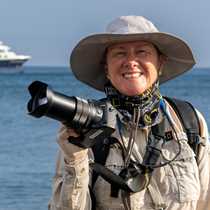Manatee River and Goff’s Cay
The weather front has pretty much moved through the area, and the morning breeze was a bit frisky outside the river mouth, but inside was cooler and calmer. The perfect temperature, in fact. Kayakers made their way up river with the wind at their backs making the paddling easy, and Zodiacs followed a little later. Herons, woodpeckers and kingfishers sat, flew and landed on red mangrove branches close to shore, or the taller black mangroves with their sage-green leaves.
We were searching for floating coconuts. Well, not really, but when the Antillean manatee (a subspecies of the West Indian manatee, those seen in Florida) comes up for a breath of air, all one can see for the most part are two enlarged holes (nostrils), with padding on either side. Since a bit of whiskers stick out also, they resemble coconuts, until they sink out of sight after just a brief, tantalizing glimpse, leaving behind only ripples. Sometimes they produce bubbles, as well. Manatees are known for serious flatulence, a behavior essentially used in buoyancy regulation, which they have perfected to an amazing degree.
Whether in kayak or Zodiac, we all saw the manatee, and more than just the nose. Some saw flippers, most of us saw their broad, brownish backs, some saw tails that were hoisted in the air before a dive. One individual had been satellite radio-tagged, however besides the occasional nose sighting, what was most easily seen was the small transistor attached to the manatee by a type of harness and line. To see this small device travel along the water surface, bobbing every now and then, opened up the world of imagination and curiosity. Who was it? How old? Where were they going? What were they doing? Perhaps if we had managed to read the number on the radio-tag, we could have continued to follow this individual on the web, but he/she proved too elusive for such an intimate encounter with our Zodiacs.
The afternoon found us cruising across from the mainland to the outer fringe of the barrier reef, destination Goff’s Cay. This tiny, white, sandy, coconut tree-covered island was our final visit of our expedition to the reefs and rivers of the Maya world. A surprisingly great snorkel and dive were our rewards for visiting this small island so close to Belize City. As the sun lowered, we snorkeled, ambled, sat or swayed in hammocks as the day closed, before finally returning to our home. Later that evening on the Sea Lion, we raised a toast to a wonderful cruise together, and the hope of traveling once again together as friends (now that we know each other) sometime in the future. Who knows where, but all of us have the same desire to visit new areas (or old), as well as meet fellow travelers (new and old), all of us on the same “wavelength.”
The weather front has pretty much moved through the area, and the morning breeze was a bit frisky outside the river mouth, but inside was cooler and calmer. The perfect temperature, in fact. Kayakers made their way up river with the wind at their backs making the paddling easy, and Zodiacs followed a little later. Herons, woodpeckers and kingfishers sat, flew and landed on red mangrove branches close to shore, or the taller black mangroves with their sage-green leaves.
We were searching for floating coconuts. Well, not really, but when the Antillean manatee (a subspecies of the West Indian manatee, those seen in Florida) comes up for a breath of air, all one can see for the most part are two enlarged holes (nostrils), with padding on either side. Since a bit of whiskers stick out also, they resemble coconuts, until they sink out of sight after just a brief, tantalizing glimpse, leaving behind only ripples. Sometimes they produce bubbles, as well. Manatees are known for serious flatulence, a behavior essentially used in buoyancy regulation, which they have perfected to an amazing degree.
Whether in kayak or Zodiac, we all saw the manatee, and more than just the nose. Some saw flippers, most of us saw their broad, brownish backs, some saw tails that were hoisted in the air before a dive. One individual had been satellite radio-tagged, however besides the occasional nose sighting, what was most easily seen was the small transistor attached to the manatee by a type of harness and line. To see this small device travel along the water surface, bobbing every now and then, opened up the world of imagination and curiosity. Who was it? How old? Where were they going? What were they doing? Perhaps if we had managed to read the number on the radio-tag, we could have continued to follow this individual on the web, but he/she proved too elusive for such an intimate encounter with our Zodiacs.
The afternoon found us cruising across from the mainland to the outer fringe of the barrier reef, destination Goff’s Cay. This tiny, white, sandy, coconut tree-covered island was our final visit of our expedition to the reefs and rivers of the Maya world. A surprisingly great snorkel and dive were our rewards for visiting this small island so close to Belize City. As the sun lowered, we snorkeled, ambled, sat or swayed in hammocks as the day closed, before finally returning to our home. Later that evening on the Sea Lion, we raised a toast to a wonderful cruise together, and the hope of traveling once again together as friends (now that we know each other) sometime in the future. Who knows where, but all of us have the same desire to visit new areas (or old), as well as meet fellow travelers (new and old), all of us on the same “wavelength.”




